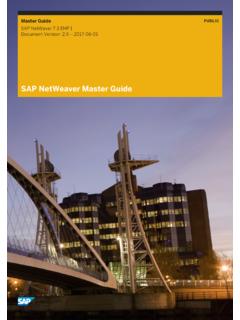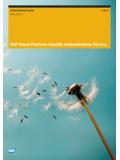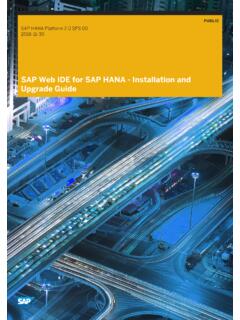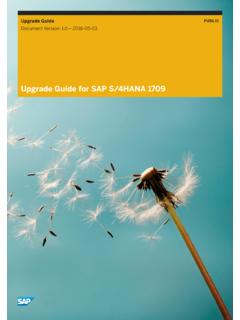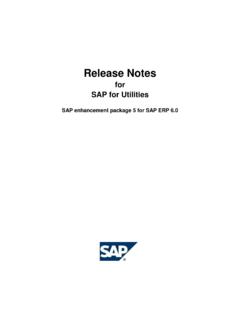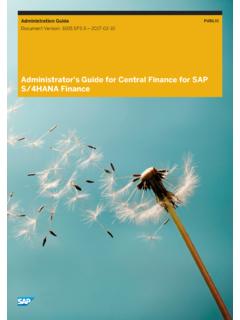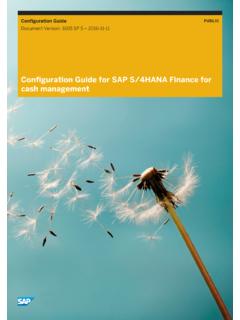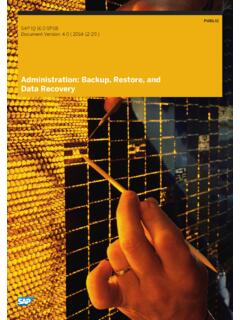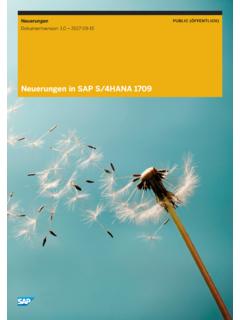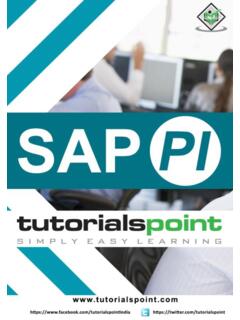Transcription of Viewing Documents Using OpenDocument - SAP
1 SAP BusinessObjects Business Intelligence platform Document Version: - 2015-01-22. Viewing Documents Using OpenDocument Content 1 Document History.. 4. 2 Getting started.. 5. About this documentation.. 5. Who should use this documentation?.. 5. About OpenDocument .. 5. What's new in SAP BusinessObjects Business Intelligence platform .. 6. Migrating your links.. 7. Changes to the default URL path.. 7. Deprecated parameters.. 7. 3 OpenDocument syntax.. 10. Basic URL syntax.. 10. URL syntax considerations.. 10. 4 Session management..13. Serialized sessions..13. Logon tokens..14. User sessions .. 15. 5 Parameter reference.. 16. Session management parameters.. 17. serSes .. 17. token .. 18. Document identifier parameters.. 20. iDocID ..20. sDocName.
2 20. sIDType .. 21. sInstance .. 22. Input parameters..22. lsC[NAME] - complex variables.. 22. lsI[NAME] - index.. 23. lsM[NAME] - multiple value variables.. 23. lsR[NAME] - range prompts.. 24. lsS[NAME] - single prompt.. 25. sRefresh .. 26. sReportName.. 26. Viewing Documents Using OpenDocument 2 2015 SAP SE or an SAP affiliate company. All rights reserved. Content Output parameters.. 27. NAII.. 27. sOutputFormat.. 28. sViewer.. 28. noDocument.. 29. Product specific parameters or usage.. 29. Analysis, edition for OLAP.. 29. Crystal Reports.. 35. Web Intelligence..40. eView and Information Spaces..44. Viewing Documents Using OpenDocument Content 2015 SAP SE or an SAP affiliate company. All rights reserved. 3. 1 Document History The following table provides an overview of the most important document changes.
3 Version Date Description SAP BusinessObjects Business May, 2013 First release of this document. Intelligence platform SAP BusinessObjects Business January, 2015 In "Crystal Reports" section, Intelligence platform updated the "lsM[NAME] - multiple value variables" sub section In "Web Intelligence" section, updated the "lsM[NAME] - multiple value variables" sub section In "Input parameters" section, updated the "lsM[NAME] - multiple value variables" sub section In "sInstance" section, updated the "Description" column Viewing Documents Using OpenDocument 4 2015 SAP SE or an SAP affiliate company. All rights reserved. Document History 2 Getting started About this documentation This documentation provides you with information for constructing parameterized URLs with the OpenDocument syntax.
4 OpenDocument URLs link to Business Intelligence (BI) Documents in an SAP BusinessObjects Business Intelligence platform system. A parameter reference, including syntax and usage examples, is provided for each OpenDocument URL parameter. For information about deploying the OpenDocument web application after the installation of the BI platform, see the SAP BusinessObjects Business Intelligence platform Web Application Deployment Guide. Who should use this documentation? This documentation is for anyone creating URLs to BI Documents with the OpenDocument syntax. We recommend consulting this guide if you are: Providing end users with hyperlinks to a document through email or other direct means. Embedding hyperlinks in one document to another.
5 Programmatically generating hyperlinks to Documents in your custom application. Familiarity with the management and organization of objects in your BI platform deployment is beneficial. About OpenDocument OpenDocument is one of many deployed web applications within a BI platform installation. It processes incoming URL requests for Documents and any other viewable object type in the Central Management Server (CMS), and delivers the correct document to the end user in the appropriate viewer. This allows you to send users direct links to a document and avoid having them navigate through a folder hierarchy, such as in BI launch pad. The OpenDocument syntax and its parameters allow you to construct URLs that link to these Documents . For example, consider the following URL: http://<servername>:<port>/BOE/ OpenDocument / iDocID=Aa6 GrrM79cRAmaOSMGoadKI&sIDType=CUID.
6 Note Replace <servername>:<port> with the name and port number of your web server where OpenDocument is deployed. Viewing Documents Using OpenDocument Getting started 2015 SAP SE or an SAP affiliate company. All rights reserved. 5. This URL accesses the object in the CMS with the CUID value of Aa6 GrrM79cRAmaOSMGoadKI. If this is a Crystal report, for example, then the report is rendered to the user in a default SAP Crystal Reports viewer. In this example, iDocID is one of many URL parameters. These parameters specify how to access a particular document in the CMS, or determine how to display the document to the user. You can link to many viewable object types with the OpenDocument syntax. Some examples include: Crystal reports Web Intelligence Documents Analysis workspaces BI launch pad workspaces Dashboards objects (formerly Xcelsius).
7 Some of the designers for these BI document types provide GUI-based URL builders to help you embed OpenDocument URLs into your Documents . Consult their respective product documentation for information on these features. What's new in SAP BusinessObjects Business Intelligence platform Expanded support for eView, Analysis for OLAP and Web Intelligence A new section in this guide has been added to better represent new and expanded support for some OpenDoc parameters for the products as follows: Analysis, edition for OLAP. lsC - complex variables lsM - multiple value variables lsR - interval variables lsS - single value variables Web Intelligence lsM - multiple value variables lsR - interval variables lsS - single value variables Viewing Documents Using OpenDocument 6 2015 SAP SE or an SAP affiliate company.
8 All rights reserved. Getting started Migrating your links Changes to the default URL path The default URL to the OpenDocument web application bundle has changed in SAP BusinessObjects Business Intelligence platform New absolute OpenDocument links need to use the new default URL: http://<servername>:<port>/BOE/ OpenDocument / ?<parameter1>. &<parameter2>. &.. &<parameterN>. If you are migrating reports with existing links from an XI release platform, resolve the issue by setting up the following redirect in your web server: Redirect: ../ OpenDocument / To: ../BOE/ OpenDocument / Note Ensure that all URL request parameters are forwarded correctly by your redirect. Refer to your web server documentation for detailed steps on implementing a redirect.
9 Note SAP BusinessObjects Business Intelligence platform only supports a Java deployment of OpenDocument . The OpenDocument web bundle is part of the file. Deprecated parameters This section lists deprecated and obsolete OpenDocument parameters as of SAP BusinessObjects Business Intelligence platform Obsolete parameters are unsupported. Note Deprecated and obsolete members as of SAP BusinessObjects Enterprise XI Service Packs are also listed for reference. Viewing Documents Using OpenDocument Getting started 2015 SAP SE or an SAP affiliate company. All rights reserved. 7. Table 5: Deprecated Parameters Parameter Description Replace with sIDType=GUID Specifies that a GUID is used to Use sIDType=CUID instead. specify the viewable document. Use Note in conjunction with iDocID.
10 Deprecated in SAP. BusinessObjects Enterprise XI. SP3). sIDType=RUID Specifies that a RUID is used to Use sIDType=CUID instead. specify the viewable document. Use Note in conjunction with iDocID. Deprecated in SAP. BusinessObjects Enterprise XI. SP3). sKind Specifies the SI_KIND property of Use iDocID instead. the target Desktop Intelligence document. sPath The file path of the target document. Use iDocID instead. Note sPath does not support the use of localized folder names which are available in this re . lease. Legacy Documents that use sPath to reference the correct folder name as stored in the CMS will continue to work while under deprecation. But it is recommended that you migrate your links to use the iDocID param . eter instead. sType Specifies the file type of the target Use iDocID instead.
